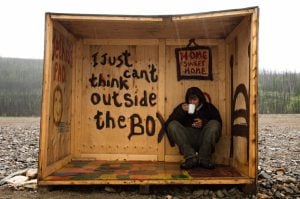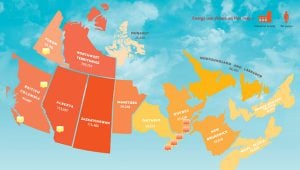
Travel
The spell of the Yukon
An insider’s account of the modern-day gold rush
- 4210 words
- 17 minutes
This article is over 5 years old and may contain outdated information.
Science & Tech

When the Klondike gold rush sparked serious growing pains in the Yukon, people flocking to the region found creative solutions: riverside shacks for sleeping and makeshift saloons for drinking. There’s another mining boom under way today — Whitehorse’s population has grown from 25,000 in 1985 to just over 35,000 last year, largely due to the influx of industry — which has prompted the territory’s power providers to try new approaches to meet the growing demand.
Yukon Energy currently generates 382 gigawatt hours (GWh) of electricity per year, 93 percent from hydro and 7 percent from diesel (the default source when hydro is tapped out). Commercial and residential demand could reach 417 GWh this year; industrial electricity use, which is 12 percent of the total demand today, could reach 40 percent by 2020. Even with the addition of a pair of hydroelectric turbines late last year, Yukon Energy cannot supply enough power.
For Jessica Thiessen, manager of the utility’s energy conservation department, reducing demand, especially during periods of peak use, is the first priority. “Demand-side management helps utilities save money, because it delays the time frame in which we need to build new energy generation,” she says, “and the customer saves money by saving electricity.”
At the household level, says Thiessen, managing demand can include “efficiency upgrades in appliances, using appliances at off-peak times or programmable thermostats.” Municipally, Yukon Energy is piloting LED street lights in Dawson, which use 64 percent less energy than traditional high-pressure sodium (HPS) lights. LEDs cost much more but have a lifespan of nearly 40 years, compared with four years for HPS lights. On the industrial side, Thiessen’s department has conducted an audit of the Alexco Bellekeno silver-lead-zinc mine and mill complex and identified potential savings from upgrading to more energy-efficient equipment and using equipment at offpeak hours. The audit also recommends appointing “energy champions” on each shift to facilitate behavioural changes that would reduce consumption.
Diesel remains a fact of life in the Yukon, especially when winter temperatures plummet, but even off-grid communities that rely on the fuel are exploring other possibilities. Burwash Landing, on Kluane First Nation land, is developing a wind-power project with independent contractor JP Pinard, who specializes in modelling wind flow in mountainous terrain.
The National Research Council first looked into Kluane First Nation wind energy in the early 1980s but concluded that wind speeds weren’t strong enough for the type of turbines available at the time. A decade later, Yukon Energy set up a wind-monitoring station at Burwash Landing and found that at about 30 metres above the ground, wind speeds were a decent six metres per second. Nothing happened until a couple of years ago, when Pinard crunched some data and determined that wind electricity could be generated at 45 to 50 cents per kilowatt hour (kWh), not much higher than the 30 cents per kWh of diesel-generated electricity — a price that’s likely to increase. Pinard estimates that a windenergy project for Burwash Landing could reduce the community’s reliance on diesel by 30 percent.
Kluane First Nation Chief Mathieya Alatini has secured federal funding to conduct feasibility studies and develop a business plan. If everything works out and the Yukon government and private investors sign on, Pinard says the wind farm could be operational by late next year. “My vision is to create something that will become a model for other places in Canada,” he says, “because there are just under 300 diesel communities in this country.”
Other energy alternatives in the Yukon include firewood — 300,000 hectares of timber were killed by the spruce bark beetle infestation between 1994 and 2002 — and additional hydro capacity, although this comes with significant environmental considerations. “The real recipe for success is having a wide range of options,” says Eric Schroff, director of Environment Yukon’s Climate Change Secretariat. “The three territories are still the frontier in Canada. We’re still trying to find out how to meet the needs of our growing populations and booming businesses.”
Are you passionate about Canadian geography?
You can support Canadian Geographic in 3 ways:

Travel
An insider’s account of the modern-day gold rush

Science & Tech
As geotracking technology on our smartphones becomes ever more sophisticated, we’re just beginning to grasps its capabilities (and possible pitfalls)

Science & Tech
Where and how we live affect how much energy we consume. Here’s what Canada would look like if the provinces and territories were scaled to represent the amount of energy they use.

Environment
Carbon capture is big business, but its challenges fly in the face of the need to lower emissions. Can we square the circle on this technological Wild West?